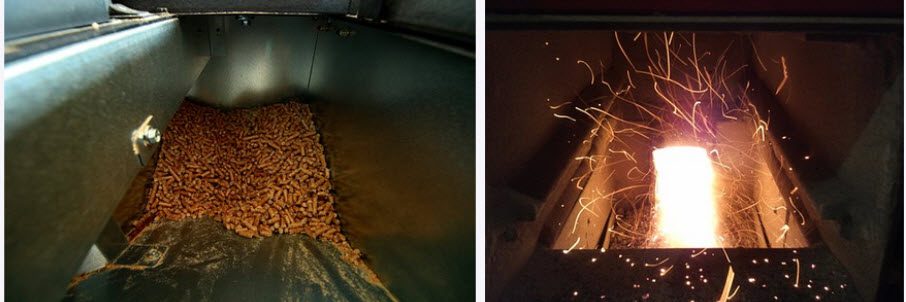When vegetable oil is used directly as a fuel in engines, boilers and furnaces – without being turned into biodiesel first – it is commonly referred to as straight vegetable oil (SVO). Some conventional diesel engines can handle straight vegetable oil without any modification, while others need to be adjusted a bit first to work well with vegetable oil. It is important that the viscosity of the vegetable oil is low enough to allow for correct atomization, otherwise an incomplete combustion may occur that will cause a build-up of carbon.
An alternative to using 100% straight vegetable oil as fuel is to mix it with petroleum-derived diesel.

Temperature
The temperature at which straight vegetable oil becomes solid vary depending on the exact source and composition of the oil. Using straight vegetable oil during winter conditions can be problematic. As an example, canola oil has a freezing point of minus 10 degrees C.
One way of overcoming the temperature problem is to install tank-heating solutions before switching to vegetable oil as fuel.
Local conditions need to be taken into account when analysing the viability of straight vegetable oil as fuel. In some Pacific Island nations, where there are no winters and coconuts are being grown locally, coconut oil is currently being explored as fuel for engines, as using coconut oil or coconut oil blends would reduce greenhouse gas emissions, reduce dependence on imported fuel, and support the local coconut industry. In many other parts of the world, using coconut oil (without substantial engine modifications) would not be feasible as it solidifies as soon as it gets colder than +17 degrees C.
Using waste oil
Each year, the food industry – including restaurants – generate vast amounts of waste oil. This is not only wasteful, but can also create serious problems in the sewage system if waste oil is flushed into the system and solidifies there. Using waste oil as fuel is therefore a win-win, as it reduces our dependence on other fuels while also keeping the waste oil out of sewage systems and landfills. Examples of major sources for waste food oil are fast-food restaurants and the industrial deep fryers found in plants where potatoes are turned into chips, French fries, etcetera.
Waste food oil that is being collected and put to good use is known under various terms, including used vegetable oil (UVO), recycled vegetable oil (RVO), waste vegetable oil (WVO), used cooking oil (UCO), and yellow grease.
Furnaces and burners
Many residential and commercial furnaces and boilers require only modest modifications to handle straight vegetable oil. This is especially true for equipment designed to burn No. 2 heating oil. An important aspect of switching to vegetable oil is to make sure the oil is not too cold when used, and preheating can be required in cool ambient temperatures. Straight vegetable oil is more viscous than biodiesel and has a higher ignition temperature.
Note: If waste oil is used, it should be filtered first.
Using vegetable oil in unmodified indirect injection engines
If you have a car or other vehicle where an indirect injection engine is supplied by in-line injection pumps or mechanical Bosch injection pumps, it may be capable of running on pure vegetable oil as long as the ambient temperature is not too low and proper maintenance is carried out. Two well-known examples of such engines are the OM616 and OM617 used for the Mercedes-Benz W123 and W124 vehicles produced from 1980 through 1985.

Modifying the fuel system
Most diesel car engines require modification to run properly on straight vegetable oil. Oil temperature is important, since too low a temperature results in a viscosity and surface tension that is too high. A way to preheat the oil is therefore needed to prevent poor atomization, incomplete combustion and carbonization.
One method is to install a heat exchange and an extra fuel tank. (One tank for diesel and another one for vegetable oil.) The cold engine is started on diesel, but switched over to vegetable oil when it has become warm enough. Shortly before being turned off at the end of the journey, the engine is turned back onto diesel to prevent vegetable oil from still being in the system when the engine cools down again.
In Europe, single-tank conversion of indirect injection engines has become a fairly common alternative to the two-tank system. Typically, the single-tank conversions are designed specifically for 100% rapeseed oil of the German DIN 51605 quality. The engine´s cold start regime is changed to assist combustion on start up and during the engine´s warm up phase. If the conversion is carried out correctly, the engine will work as long as the ambient temperature does not go below minus 10 degrees C.
Direct injection engines are more complicated in this regard, but there is one notable exception: the Volkswagen Turbocharged Direct Injection (TDI) engine. For this particular engine, several German companies offer single-tank conversions and instructions for proper engine maintenance.
Modifying the fuel
The comparatively high kinematic viscosity of pure vegetable oil can be reduced by diluting the oil with a low-molecular-weight solvent. The resulting fuel blend is more suitable for conventional compression-ignition engines than pure vegetable oil, but has been linked to an increased risk of damage to fuel pumps and piston rings.
Background
An engine fuelled by vegetable oil might seem like a newfangled idea for an environmentally conscious age, but Rudolf Diesel himself actually created this type of engine back in the early 1900s.
Rudolf Diesel, the inventor of the diesel engine, initially wanted to create an engine capable of using coal dust as fuel. When this didn´t work out according to plan, he designed an engine for vegetable oil instead, one which he hoped would be attractive to farmers – since they could grow their own engine fuel.
“The fact that fat oils from vegetable sources can be used may seem insignificant today, but such oils may perhaps become in course of time of the same importance as some natural mineral oils and the tar products are now.” – Rudolf Diesel, at a 1912 presentation to the British Institute of Mechanical Engineers.

